The Status of Genetic Resources and Olive Breeding in Tunisia
Abstract
:1. Introduction
2. Importance of Olive Tree in Tunisia
3. Diversity of Olive Genetic Resources in Tunisia as Reservoir for Varieties Selection
4. Identification and Authentication
5. Olive Breeding in Tunisia
6. Perspectives
Author Contributions
Funding
Institutional Review Board Statement
Informed Consent Statement
Data Availability Statement
Conflicts of Interest
References
- Fanelli, V.; Mascio, I.; Falek, W.; Miazzi, M.M.; Montemurro, C. Current Status of Biodiversity Assessment and Conservation of Wild Olive (Olea europaea L. subsp. europaea var. sylvestris). Plants 2022, 11, 480. [Google Scholar] [CrossRef]
- Besnard, G.; Terral, J.F.; Cornille, A. On the origins and domestication of the olive: A review and perspectives. Ann. Bot. 2018, 121, 385–403. [Google Scholar] [CrossRef] [PubMed] [Green Version]
- Famiani, F.; Farinelli, D.; Gardi, T.; Rosati, A. The cost of flowering in olive (Olea europaea L.). Sci. Hortic. 2019, 252, 268–273. [Google Scholar] [CrossRef]
- Rugini, E.; Cristofori, V.; Silvestri, C. Biotechnology Advances. Genetic Improvement of Olive (Olea europaea L.) by Conventional and In Vitro Biotechnology Methods; Elsevier: Amsterdam, The Netherlands, 2016. [Google Scholar]
- FAO. The Second Report on the State of the World’s Plant Genetic Resources for Food and Agriculture; FAO: Rome, Italy, 2010. [Google Scholar]
- FAOSTAT. Available online: htpps://www.fao/faostat/en/#data/QCL (accessed on 20 May 2022).
- Moriondo, M.; Ferrise, R.; Trombi, G.; Brilli, L.; Dibari, C.; Bindi, M. Modelling olive trees and grapevines in a changing climate. Environ. Model. Softw. 2015, 72, 387–401. [Google Scholar] [CrossRef]
- De Ollas, C.; Morillón, R.; Fotopoulos, V.; Puértolas, J.; Ollitrault, P.; Gómez-Cadenas, A.; Arbona, V. Facing climate change: Biotechnology of iconic Mediterranean woody crops. Front. Plant Sci. 2019, 10, 427. [Google Scholar] [CrossRef]
- Fraga, H.; Moriondo, M.; Leolini, L.; Santos, J.A. Mediterranean olive orchards under climate change: A review of future impacts and adaptation strategies. Agronomy 2021, 11, 56. [Google Scholar] [CrossRef]
- Di Rienzo, V.; Sion, S.; Taranto, F.; D’Agostino, N.; Montemurro, C.; Fanelli, V.; Sabetta, W.; Boucheffa, S.; Tamendjari, A.; Pasqualone, A.; et al. Genetic flow among olive populations within the Mediterranean basin. Peer J. 2018, 18, e5260. [Google Scholar] [CrossRef] [Green Version]
- Díaz-Rueda, P.; Franco-Navarro, J.D.; Messora, R.; Espartero, J.; Rivero-Núñez, C.M.; Aleza, P.; Capote, N.; Cantos, M.; García-Fernández, J.L.; de Cires, A.; et al. A Germplasm Collection of Wild Subspecies with High Genetic Variability as a Source of Rootstocks and Resistance Genes for Olive Breeding. Front. Plant Sci. 2020, 11, 629. [Google Scholar] [CrossRef]
- Trujillo, I.; Ojeda, M.A.; Urdiroz, N.M.; Potter, D.; Barranco, D.; Rallo, L.; Diez, C.M. Identification of the Worldwide Olive Germplasm Bank of Córdoba (Spain) using SSR and morphological markers. Tree Genet. Gen. 2014, 10, 141–155. [Google Scholar] [CrossRef]
- Diez, C.M.; Moral, J.; Barranco, D.; Rallo, L. Genetic diversity and conservation of olive genetic resources. In Genetic Diversity and Erosion in Plants: Case Histories; Sustainable Development and Biodiversity, Series; Ahuja, M.R., Mohan Jain, S., Eds.; Springer: Basel, Switzerland, 2016; Volume 8, pp. 337–356. [Google Scholar]
- Di Rienzo, V.; Miazzi, M.M.; Fanelli, V.; Sabetta, W.; Montemurro, C. The preservation and characterization of Apulian olive germplasm biodiversity. Acta Hort. 2018, 1199, 1–6. [Google Scholar] [CrossRef]
- Khadari, B.; El Bakkali, A.; Essalouh, L.; Tollon, C.; Pinatel, C.; Besnard, G. Cultivated Olive Diversification at Local and Regional Scales: Evidence from the Genetic Characterization of French Genetic Resources. Front. Plant Sci. 2019, 10, 1593. [Google Scholar] [CrossRef] [Green Version]
- Sion, S.; Taranto, F.; Montemurro, C.; Mangini, G.; Camposeo, S.; Falco, V.; Gallo, A.; Mita, G.; Saddoud Debbabi, O.; Ben Amar, F.; et al. Genetic Characterization of Apulian Olive Germplasm as Potential Source in New Breeding Programs. Plants 2019, 8, 268. [Google Scholar] [CrossRef] [Green Version]
- Taranto, F.; Francese, G.; Di Dato, F.; D’Alessandro, A.; Greco, B.; Onofaro Sanajà, V.; Pentangelo, A.; Mennella, G.; Tripodi, P. Leaf metabolic, genetic, and morphophysiological profiles of cultivated and wild rocket salad (Eruca and Diplotaxis spp.). J. Agric. Food Chem. 2016, 64, 5824–5836. [Google Scholar] [CrossRef]
- Taranto, F.; Nicolia, A.; Pavan, S.; De Vita, P.; D’Agostino, N. Biotechnological and digital revolution for climate-smart plant breeding. Agronomy 2018, 8, 277. [Google Scholar] [CrossRef] [Green Version]
- Miazzi, M.M.; D’Agostino, N.; di Rienzo, V.; Venerito, P.; Savino, V.N.; Fucilli, V.; Ruffa, P.; Roseti, V.; Pirolo, C.; La Notte, P.; et al. Marginal Grapevine Germplasm from Apulia (Southern Italy) Represents an Unexplored Source of Genetic Diversity. Agronomy 2020, 10, 563. [Google Scholar] [CrossRef] [Green Version]
- Miazzi, M.M.; D’Agostino, N.; Gadaleta, S.; Montemurro, C.; Taranto, F. Genotyping-by-sequencing-derived single-nucleotide polymorphism catalog from a grapevine (Vitis vinifera L.) germplasm collection that includes the most representative Apulian autochthonous cultivars. Acta Hortic. 2019, 1248, 69–75. [Google Scholar] [CrossRef]
- Islam, A.S.M.F.; Sanders, D.; Mishra, A.K.; Joshi, V. Genetic Diversity and Population Structure Analysis of the USDA Olive Germplasm Using Genotyping-By-Sequencing (GBS). Genes 2021, 12, 2007. [Google Scholar] [CrossRef]
- Julca, I.; Marcet-Houben, M.; Cruz, F.; Gómez-Garrido, J.; Gaut, B.S.; Díez, C.M.; Gut, I.G.; Alioto, T.S.; Vargas, P.; Gabaldón, T. Genomic evidence for recurrent genetic admixture during the domestication of Mediterranean olive trees (Olea europaea L.). BMC Biol. 2020, 18, 148. [Google Scholar] [CrossRef]
- Li, J.; Ji, X.; Wang, Z.; Zeng, Y.; Zhang, J. Morphological, Molecular and Genomic Characterization of Two Inter-Subspecific Hybrids between Olive Cultivars and Olive Subspecies. Horticulturae 2021, 7, 138. [Google Scholar] [CrossRef]
- Manolikaki, I.; Sergentani, C.; Tul, S.; Koubouris, G. Introducing Three-Dimensional Scanning for Phenotyping of Olive Fruits Based on an Extensive Germplasm Survey. Plants 2022, 11, 1501. [Google Scholar] [CrossRef]
- Pasqualone, A.; di Rienzo, V.D.; Miazzi, M.M.; Fanelli, V.; Caponio, F.; Montemurro, C. High resolution melting analysis of DNA microsatellites in olive pastes and virgin olive oils obtained by talc addition. Eur. J. Lip. Sci. Technol. 2015, 117, 2044–2048. [Google Scholar] [CrossRef]
- Sabetta, W.; Miazzi, M.M.; Di Rienzo, V.; Pasqualone, A.; Montemurro, C. Development and application of protocols to certify the authenticity and traceability of Apulian typical products in olive sector. Riv. Ital. Delle Sostanze Grasse 2017, 94, 37–43. [Google Scholar]
- Fanelli, V.; Mascio, I.; Miazzi, M.M.; De Giovanni, C.; Montemurro, C. Molecular approaches to agri-food traceability and authentication: An updated review. Foods 2021, 10, 1644. [Google Scholar] [CrossRef]
- Rodríguez-Cohard, J.C.; Sánchez-Martínez, J.D.; Garrido-Almonacid, A. Strategic responses of the European olive-growing territories to the challenge of globalization. Eur. Plan. Stud. 2020, 28, 2261–2283. [Google Scholar] [CrossRef]
- Medina, E.; Morales-Sillero, A.; Ramìrez, E.M.; Rallo, P.; Brenes, M.; Romero, C. New genotypes of table olives: Profile of bioactive compounds. Int. J. Food. Sci. Technol. 2012, 47, 2334–2341. [Google Scholar] [CrossRef]
- Lavee, S.; Avidan, B.; Meni, Y.; Haskal, A.; Wodner, M. Three new semi-dwarf varieties of olive tree for table use. Olivae 2004, 102, 33–41. [Google Scholar]
- Lavee, S. New table olive varieties intended for harvest facilitation. In Jornadas Internacionales de la Aceituna de Mesa; Dos Hermanas: Seville, Spain, 2008. [Google Scholar]
- Rallo, L. Breeding oil and table olives for mechanical harvesting in Spain. HortTechnology 2014, 24, 295–300. [Google Scholar] [CrossRef] [Green Version]
- Pérez, A.G.; León, L.; Sanz, C.; de la Rosa, R. Fruit Phenolic Profiling: A New Selection Criterion in Olive Breeding Programs. Front. Plant Sci. 2018, 9, 241. [Google Scholar] [CrossRef] [Green Version]
- Sion, S.; Savoia, M.A.; Gadaleta, S.; Piarulli, L.; Mascio, I.; Fanelli, V.; Montemurro, C.; Miazzi, M.M. How to Choose a Good Marker to Analyze the Olive Germplasm (Olea europaea L.) and Derived Products. Genes 2021, 12, 1474. [Google Scholar] [CrossRef]
- Miazzi, M.M.; di Rienzo, V.; Mascio, I.; Montemurro, C.; Sion, S.; Sabetta, W.; Vivaldi, G.A.; Camposeo, S.; Caponio, F.; Squeo, G.; et al. Re.Ger.O.P.: An Integrated Project for the Recovery of Ancient and Rare Olive Germplasm. Front. Plant Sci. 2020, 11, 73. [Google Scholar] [CrossRef] [PubMed] [Green Version]
- León, L.; de la Rosa, R.; Arriaza, M. Prioritization of olive breeding objectives in Spain: Analysis of a producers and researchers survey. Span. J. Agric. Res. 2021, 19, e0701. [Google Scholar] [CrossRef]
- Montilon, V.; Susca, L.; Potere, O.; Roseti, V.; Campanale, A.; Saponari, A.; Montemurro, C.; Fanelli, V.; Venerito, P.; Bottalico, G. Embryo Culture, in vitro Propagation, and Molecular Identification for Advanced Olive Breeding Programs. Horticulturae 2022, 8, 36. [Google Scholar] [CrossRef]
- De la Rosa, R.; Arias-Calderón, R.; Velasco, L.; León, L. Early selection for oil quality components in olive breeding progenies Europ. J. Lipid Sci. Technol. 2016, 118, 1160–1167. [Google Scholar] [CrossRef]
- Rugini, E.; De Pace, C. Olive breeding with classical and modern approaches. In The Olive Tree Genome. Compendium of Plant Genomes; Rugini, E., Baldoni, L., Muleo, R., Sebastiani, L., Eds.; Springer: Berlin/Heidelberg, Germany, 2016; pp. 163–193. [Google Scholar]
- Rjiba, I.; Debbou, S.; Gazzah, N.; Chreif, I.; Hammami, M. Profiles of volatile compounds from nine new hybrids obtained by controlled crossings on olive ‘Chemlali’ cultivar and mediterranean varieties. Nat. Prod. Res. 2009, 23, 622–632. [Google Scholar] [CrossRef]
- Boucheffa, S.; Tamendjari, A.; Sanchez-Gimeno, A.C.; Rovellini, P.; Venturini, S.; di Rienzo, V.; Miazzi, M.M.; Montemurro, C. Diversity Assessment of Algerian Wild and Cultivated Olives (Olea europeae L.) by Molecular, Morphological, and Chemical Traits. Eur. J. Lipid Sci. Technol. 2019, 121, 1800302. [Google Scholar] [CrossRef] [Green Version]
- Rallo, L.; Barranco, D.; De la Rosa, R.; León, L. “Chiquitita” olive. HortScience 2008, 43, 529–533. [Google Scholar] [CrossRef]
- Bellini, E.; Giordani, E.; Parlati, M.V.; Pandolfi, S. Olive genetic improvement: Thirty years of research. Acta Hortic. 2002, 586, 105–108. [Google Scholar] [CrossRef] [Green Version]
- Clodoveo, M.L.; Yangui, A.; Fendri, M.; Giordano, S.; Crupi, P.; Corbo, F. Protected Geographical Indications for EVOO in Tunisia: Towards Environmental, Social, and Economic Sustainable Development. Sustainability 2021, 13, 11201. [Google Scholar] [CrossRef]
- Tunisian Agriculture Ministry-General Direction of Agricultural Production. Available online: http://www.agriculture.tn (accessed on 20 January 2022).
- Ben Abdallah, S.; Elfkih, S.; Parra-Lopez, C. A sustainability comparative assessment of Tunisian organic and conventional olive growing systems based on the ahp methodology. N. Medit. 2018, 17, 158–160. [Google Scholar] [CrossRef]
- Rejeb, A.; Keogh, J.G. Applying HACCP in the Tunisian Olive Oil Industry: A Theoretical Background. J. Bus. Manag. Econ. Res. 2019, 3, 1–18. [Google Scholar] [CrossRef]
- Besnard, G.; El Bakkali, A.; Haouane, H.; Baali-Cherif, D.; Moukhli, A.; Khadari, B. Population genetics of Mediterranean and Saharan olives: Geographic patterns of differentiation and evidence for early generations of admixture. Ann. Bot. 2013, 12, 1293–1302. [Google Scholar] [CrossRef] [Green Version]
- Saddoud Debbabi, O.; Rahmani Mnasri, S.; Ben Amar, F.; Ben Naceur, M.; Montemurro, C.; Miazzi, M.M. Applications of Microsatellite Markers for the Characterization of Olive Genetic Resources of Tunisia. Genes 2021, 12, 286. [Google Scholar] [CrossRef]
- Trigui, A.; Msallem, M. Oliviers de Tunisie: Catalogue des Variétés Autochtones and Types Locaux: Identification Variétale and Caractérisation Morpho-pomologique des Ressources Génétiques Oléicoles de Tunisie; Institution de la Recherche et de l’Enseignement Supérieur Agricoles: Tunis, Tunisia, 2002; Volume 1, p. 159. [Google Scholar]
- Laaribi, I.; Gouta, H.; Ayachi, M.M.; Labidi, F.; Mars, M. Combination of morphological and molecular markers for the characterization of ancient native olive accessions in Central-Eastern Tunisia. Comptes Rendus Biol. 2017, 340, 287–297. [Google Scholar] [CrossRef]
- Khabou, W.; Ben Amar, F.; Gharsallaoui, M.; Ayadi, M. Agronomic and technological performances of olive tree varieties (Olea europaea L.) in collection in the region of Sfax (Tunisia). In Proceedings of the Second International Seminar Olivebioteq, Marsala, Italy, 5–10 November 2006; Campo Artigrafiche: Alcamo, Italy, 2006; Volume 1, pp. 433–436. [Google Scholar]
- Grati-Kamoun, N.; Khlif, M. Caractérisation Technologique des Variétés d’Olivier Cultivées en Tunisie; Special Number; Revue Ezzitouna: Tunis, Tunisia, 2001; pp. 69–74. [Google Scholar]
- Zarrouk, W.; Baccouri, B.; Taamalli, W.; Trigui, A.; Daoud, D.; Zarrouk, M. Oil fatty acid composition of eighteen Mediterranean olive varieties cultivated under the arid conditions of Boughrara (southern Tunisia). Grasas Y Aceites 2009, 60, 498–506. [Google Scholar] [CrossRef] [Green Version]
- Taranto, F.; D’Agostino, N.; Pavan, S.; Perri, E.; Fanelli, V.; Di Rienzo, V.; Sabetta, W.; Miazzi, M.M.; Zelasco, S.; Montemurro, C. Single nucleotide polymorphism (SNP) diversity in an olive germplasm collection. Acta Hortic. 2018, 1199, 27–32. [Google Scholar] [CrossRef]
- Batrinou, A.; Strati, I.F.; Houhoula, D.; Tsaknis, J.; Sinanoglou, V.J. Authentication of olive oil based on DNA analysis. Grasasaceites 2020, 71, e366. [Google Scholar] [CrossRef]
- Grati Kamoun, N.; Lamy Mahmoud, M.; Rebai, A.; Gargouri, A.; Panaud, O.; Saar, A. Genetic diversity of Tunisian olive tree (Olea europea L.) cultivars assessed by AFLP markers. Gent. Res. Crop. Evol. 2006, 53, 265–275. [Google Scholar] [CrossRef]
- Ben Ali, S.B.; Mohamed, M.B.; Guasmi, F.; Triki, T.; Kammoun, N.G.; Kamel, N. Genetic variability of Tunisian olive cultivars by ISSR and SSR markers. Agri Biotech 2011, 24, 1098–1107. [Google Scholar]
- Rekik, I.; Salimonti, A.; GratiKamoun, N.; Muzzalupo, I.; Lepais, O.; Gerber, S.; Perri, E.; Rebai, A. Characterization and Identification of Tunisian Olive Tree Varieties by Microsatellite Markers. HortScience 2008, 43, 1371–1376. [Google Scholar] [CrossRef]
- Fendri, M.; Trujillo, I.; Trigui, A.; Rodriguez-Garcia, I.M.; Ramirez, J.D.A. Simple Sequence Repeat identification and endocarp characterization of olive accessions in a Tunisian germplasm collection. HortScience 2010, 45, 1429–1436. [Google Scholar] [CrossRef] [Green Version]
- Ben Mohamed, M.B.; Zelasco, S.; Ben Ali, S.; Guasmi, F.; Triki, T.; Conforti, F.L.; Naziha, G.K. Exploring olive tree genetic variability in the southeast of Tunisia. GMR 2017, 16, gmr16039850. [Google Scholar] [CrossRef]
- Abdelhamid, S.; Omri, A.; Grati-Kamoun, N.; Paolo Marra, F.; Caruso, T. Molecular characterization and genetic relationships of cultivated Tunisian olive varieties (Olea europaea L.) using SSR markers. J. N. Sci. 2017, 40, 2175–2185. [Google Scholar]
- Ben Ayed, R.; Kallel, I.; Ben Hassen, H.; Rebai, A. SNP marker analysis for validating the authenticity of Tunisian olive oil. J. Genet. 2014, 93, 48–54. [Google Scholar]
- Ben Ayed, R.; Rebai, A. Tunisian Table Olive Oil Traceability and Quality Using SNP Genotyping and Bioinformatics Tools. BioMed Res. Int. 2019, 9, 8291341. [Google Scholar] [CrossRef]
- Hannachi, H.; Breton, C.; Msallem, M.; Ben El Hadj, S.; El Gazzah, M.; Bervillé, A. Genetic relationships between cultivated and wild olive trees (Olea europaea L. var. europaea and var. sylvestris) based on nuclear and chloroplast SSR markers. Nat. Resour. 2010, 1, 95–103. [Google Scholar] [CrossRef] [Green Version]
- Mezghani Aichi, M.; Mguidiche, A.; Allouche Khebour, F.; Zouari, I.; Faouzi, A.; Provenzano, G. Water Status and Yield Response to Deficit Irrigation and Fertilization of Three Olive Oil Cultivars under the Semi-Arid Conditions of Tunisia. Sustainability 2019, 11, 4812. [Google Scholar] [CrossRef] [Green Version]
- Ben Amar, F.; Mezghani-Aiachi, M.; Yengui, A.; Belguith, H.; Harrab, S.; Hergli, M.K. Variability in the agronomic performance of a collection of olive hybrids (Olea europaea L.) of the local ‘Chemlali Sfax’ oil-olive variety. Olivae 2015, 122, 16–21. [Google Scholar]
- Guellaoui, I.; Ben Amar, F.; Triki, M.A.; Ayadi, M.; Boubaker, M. Chemlali Mhassen: New olive cultivar derived from crossbreeding program in Tunisia with high oil quality and productivity. J. Sci. Agric. 2021, 5, 32–35. [Google Scholar] [CrossRef]
- Hannachi, H.; Nasri, N.; Elfalleh, W.; Tlili, N.; Ferchichi, A.; Msallem, M. Fatty Acids, Sterols, Polyphenols, and Chlorophylls of Olive Oils Obtained from Tunisian Wild Olive Trees (Olea europaea L. var. sylvestris). Intern. J. Food Prop. 2013, 16, 1271–1283. [Google Scholar] [CrossRef]
- Ben Amar, F.; Guellaoui, I.; Ayadi, A.; Elloumi, O.; Triki, M.A.; Boubaker, M. ‘Zeitoun Ennour’: A new olive (Olea europaea L.) cultivar in Tunisia with high oil quality. Genet. Resour. 2021, 2, 1–6. [Google Scholar] [CrossRef]
- Dabbou, S.; Rjiba, I.; Echbili, A.; Gazzah, N.; Mechri, B.; Hammami, M. Effect of controlled crossing on the triglyceride and fatty acid composition of virgin olive oils. Chem. Biodivers. 2010, 7, 1801–1813. [Google Scholar] [CrossRef]
- Omri, A.; Abdelhamid, S.; Benincasa, C.; Araouki, A.; Ayadi, M.; Gharsallaoui, M.; Gouiaa, M. Genetic diversity and association of molecular markers with biochemical traits in Tunisian olive cultivars. Genet. Resour. Crop. Evol. 2020, 68, 1181–1197. [Google Scholar] [CrossRef]
- Chtourou, F.; Valli, E.; Ben Mansour, A.; Bendini, A.; Gallina Toschi, T.; Bouaziz, M. Characterization of virgin olive oils obtained from minor Tunisian varieties for their valorization. Food Meas. 2021, 15, 5060–5070. [Google Scholar] [CrossRef]
- Dridi, J.; Fendri, M.; Breton, C.M.; Msallem, M. Characterization of olive progenies derived from a Tunisian breeding program by morphological traits and SSR markers. Sci. Hortic. 2018, 236, 12–136. [Google Scholar] [CrossRef]
- Saddoud Debbabi, O.; Miazzi, M.M.; Elloumi, O.; Fendri, M.; Ben Amar, F.; Savoia, M.; Sion, S.; Souabni, H.; Rahmani Mnasri, S.; Ben Abdelaali, S.; et al. Recovery, assessment, and molecular characterization of minor olive genotypes in Tunisia. Plants 2020, 9, 382. [Google Scholar] [CrossRef] [Green Version]
- Saddoud Debbabi, O.; Montemurro, C.; Ben Maachia, S.; Ben Amar, F.; Fanelli, F.; Gadaleta, S.; El Riachy, M.; Chehade, A.; Siblini, M.; Boucheffa, S.; et al. A Hot-spot of Olive Biodiversity in the Tunisian Oasis of Degache. Diversity 2020, 12, 358. [Google Scholar] [CrossRef]
- Triki, M.A.; Hassaïri, A.; Mahjoub, M. Premières observations de Verticillium dahliae sur olivier en Tunisie. Bulletin. OEPP/EPPO 2006, 36, 69–71. [Google Scholar] [CrossRef]
- Boughalleb-M’Hamdi, N.; Souli, M.; Ben Salem, I.; Selmi, S.; Romdhani, M.E. Screening of fungi implicated in the dieback of olive trees (Olea europea) in Chebika’s area. Res. Plant Biol. 2011, 1, 33–38. [Google Scholar]
- Chliyeh, M.; Touati, J.; Selmaoui, K.; Ouazzani Touhami, A.; Filali-Maltouf, A.; Cherkaoui, E.M.; Moukhli, A.; Benkirane, R.; Douira, A. Bibliographic Inventory of the Olive Tree (Olea europaea L.) Fungal Diseases in the World. Int. J. Pure App. Biosci. 2014, 2, 46–79. [Google Scholar]
- Triki, M.A.; Krid, S.; Hsairi, H.; Hammemi, I.; Radouane Gdoura, R.I.; Rhouma, A. Occurrence of Verticillium dahliae defoliating pathotypes on olive trees in Tunisia. Phytopathol. Mediterr. 2011, 50, 267–272. [Google Scholar]
- Pavan, S.; Vergine, M.; Nicolì, F.; Sabella, E.; Aprile, A.; Negro, C.; Fanelli, V.; Savoia, M.A.; Montilon, V.; Susca, L.; et al. Screening of Olive Biodiversity Defines Genotypes Potentially Resistant to Xylella fastidiosa. Front. Plant Sci. 2021, 12, 723879. [Google Scholar] [CrossRef] [PubMed]
- Besnard, G.; Anthelme, F.; Baali-Cherif, D. The Laperrine’s olive tree (Oleaceae): A wild genetic resource of the cultivated olive and a model-species for studying the biogeography of the Saharan Mountains. Acta Bot. Gall. 2012, 159, 319–328. [Google Scholar] [CrossRef]
- Falek, W.; Sion, S.; Montemurro, C.; Khelifi, D.; Miazzi, M.M. Molecular diversity and ecogeographic distribution of Algerian wild olives (Olea europaea subsp. europaea var. sylvestris). Sci. Agric. 2022, 79, e20200308leck. [Google Scholar] [CrossRef]
- Camps-Fabrer, H. La culture de l’olivier en Afrique du Nord, Evolution et histoire. In Encyclopédie Mondial de l’Olivier; International Olive Oil Council: Madrid, Spain, 1997; pp. 30–33. [Google Scholar]
- Díaz-Rueda, P.; Aguado, A.; Romero-Cuadrado, L.; Capote, N.; Colmenero-Flores, J.M. Wild olive genotypes as a valuable source of resistance to defoliating Verticillium dahliae. Front. Plant Sci. 2021, 12, 662060. [Google Scholar] [CrossRef]
- Palomares-Rius, J.E.; Belaj, A.; León, L.; de la Rosa, R.; Rapoport, H.F.; Castillo, P. Evaluation of the phytopathological reaction of wild and cultivated olives as a means of finding promising new sources of genetic diversity for resistance to root-knot nematodes. Plant Dis. 2019, 103, 2559–2568. [Google Scholar] [CrossRef] [Green Version]
- Hernández-Santana, V.; Diaz-Rueda, P.; Diaz-Espejo, A.; Raya-Sereno, M.D.; Gutierrez-Gordillo, S.; Montero, A.; Perez-Martin, A.; Colmenero-Flores, J.M.; Rodriguez-Dominguez, C.M. Hydraulic traits emerge as relevant determinants of growth patterns in wild olive genotypes under water stress. Front. Plant Sci. 2019, 10, 291. [Google Scholar] [CrossRef]
- Chartzoulakis, K.S. Salinity and olive: Growth, salt tolerance, photosynthesis and yield. Agric. Water Manag. 2005, 78, 108–121. [Google Scholar] [CrossRef]
- Trigui, A. L’amélioration quantitative et qualitative de la production oléicole en Tunisie: L’incontournable nécessité et les perspectives de l’identification et de l’amélioration génétique de l’olivier. Olivae 1996, 61, 34–40. [Google Scholar]
- Trigui, A.; Msallem, M. L’amélioration génétique par croisement dirigé de l’olivier (Olea europaea L.) cv Chemlali Sfax et Meski: Rapport final. In Proceedings of the Symposium de Clôture du Projet AGO (COI/FCPB), Cairo, Egypt, 25–28 June 2001; p. 51. [Google Scholar]
- Manaï, H.; Mahjoub-Haddada, F.; Trigui, A.; Daoud, D.; Zarrouk, M. Compositional quality of virgin olive oil from two new Tunisian cultivars obtained through controlled crossings. J. Sci. Food Agric. 2007, 87, 600–606. [Google Scholar] [CrossRef]
- JORT. Official Journal of Republic of Tunisia. 2017; Volume 33, p. 1318. Available online: http://www.iort.gov.tn/WD120AWP/WD120Awp.exe/CONNECT/SITEIORT (accessed on 20 January 2022).
- Varshney, R.K.; Terauchi, R.; McCouch, S.R. Harvesting the promising fruits of genomics: Applying genome sequencing technologies to crop breeding. PLoS Biol. 2014, 12, e1001883. [Google Scholar] [CrossRef] [Green Version]
- D’Agostino, N.; Taranto, F.; Camposeo, S.; Mangini, G.; Fanelli, V.; Gadaleta, S.; Miazzi, M.M.; Pavan, S.; Di Rienzo, V.; Sabetta, W.; et al. GBS-derived SNP catalogue unveiled wide genetic variability and geographical relationships of Italian olive cultivars. Sci. Rep. 2018, 8, 15877. [Google Scholar] [CrossRef] [Green Version]
- Muleo, R.; Morgante, M.; Velasco, R.; Cavallini, A.; Perrotta, G.; Baldoni, L. Olive tree genomic. In Olive Germplasm. The Olive Cultivation, Table and Olive Oil Industry in Italy; Mazzalupo, I., Ed.; In Tech: Rijeka, Croatia, 2012; pp. 133–148. [Google Scholar]
- Sánchez-Romero, C. Somatic Embryogenesis in Olive. Plants 2021, 10, 433. [Google Scholar] [CrossRef]
- Bashir, M.A.; Silvestri, C.; Salimonti, A.; Rugini, E.; Cristofori, V.; Zelasco, S. Can Ethylene Inhibitors Enhance the Success of Olive Somatic Embryogenesis? Plants 2022, 9, 168. [Google Scholar] [CrossRef]
- Palomo-Ríos, E.; Narváez, I.; Pliego-Alfaro, F.; Mercado, J.A. Olive (Olea europaea L.) Genetic Transformation: Current Status and Future Prospects. Genes 2021, 12, 386. [Google Scholar] [CrossRef]
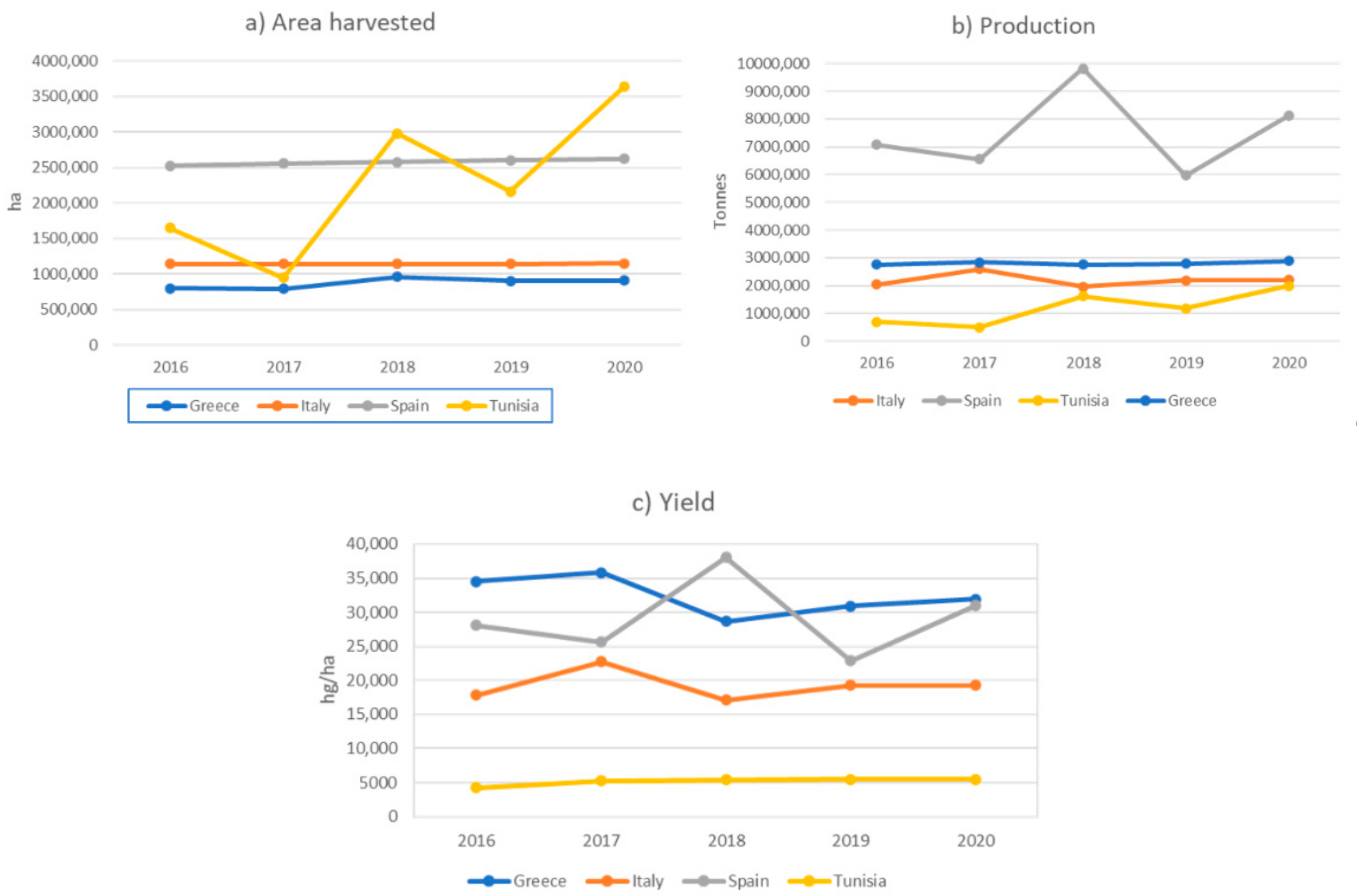
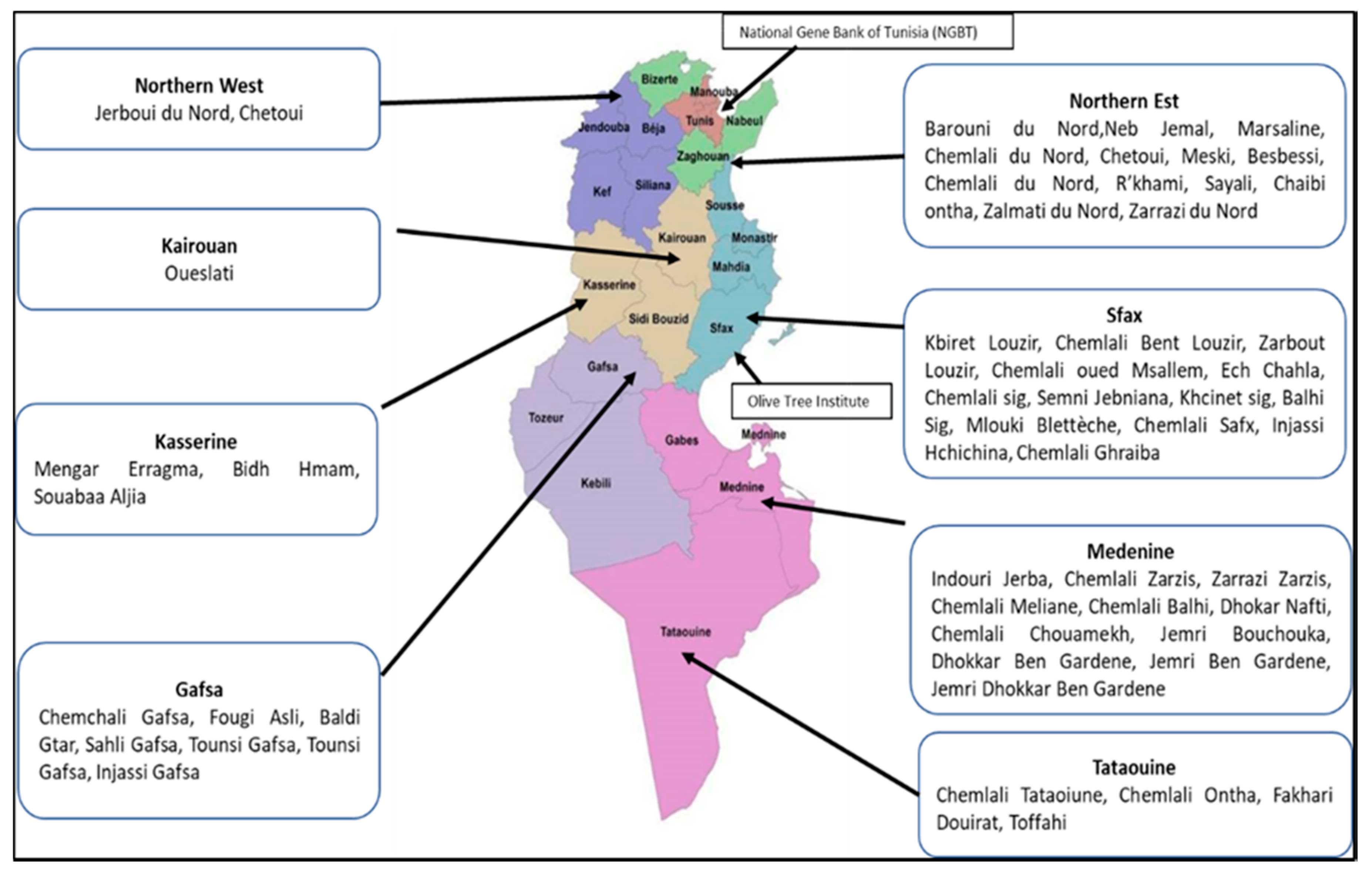
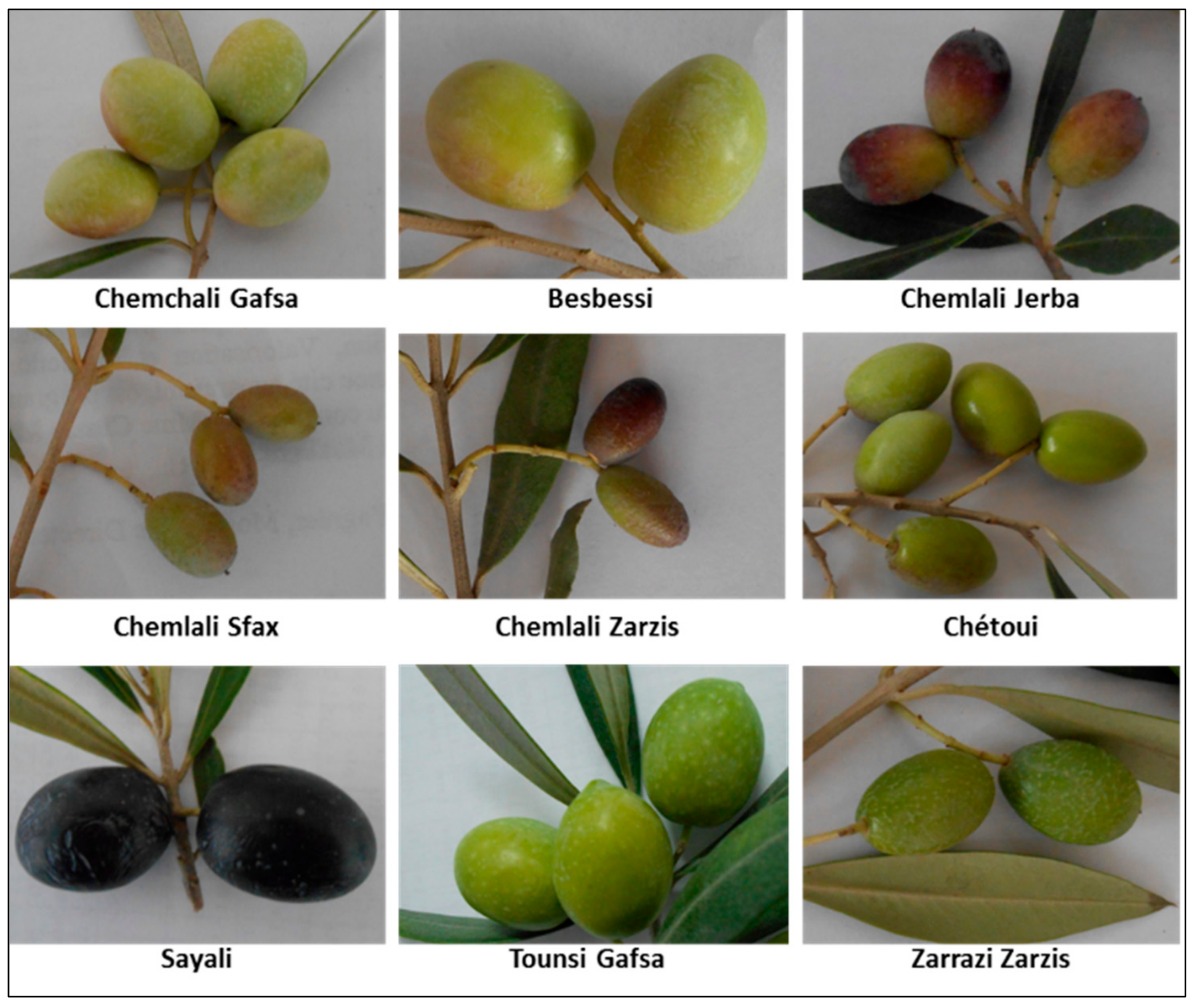
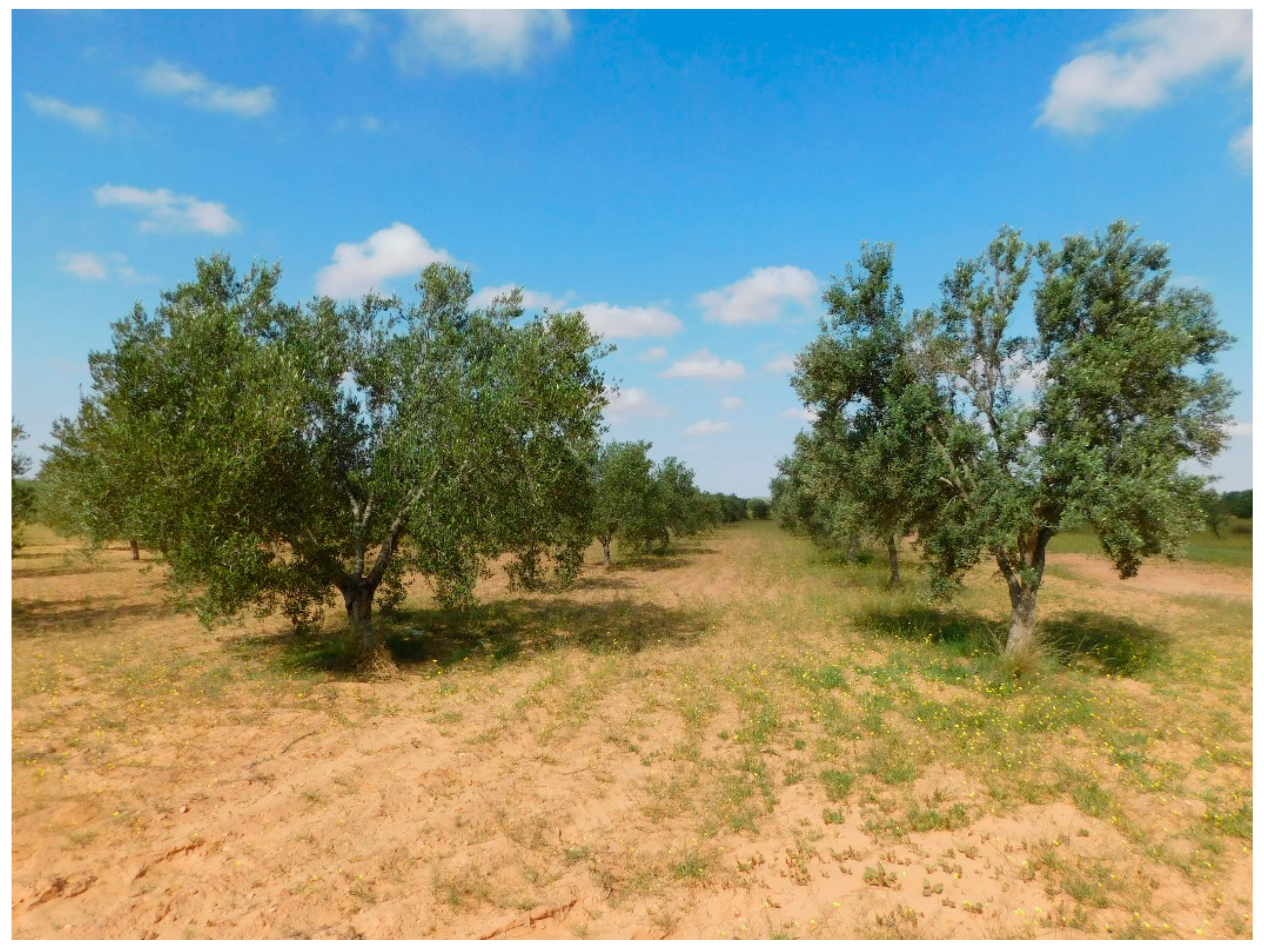
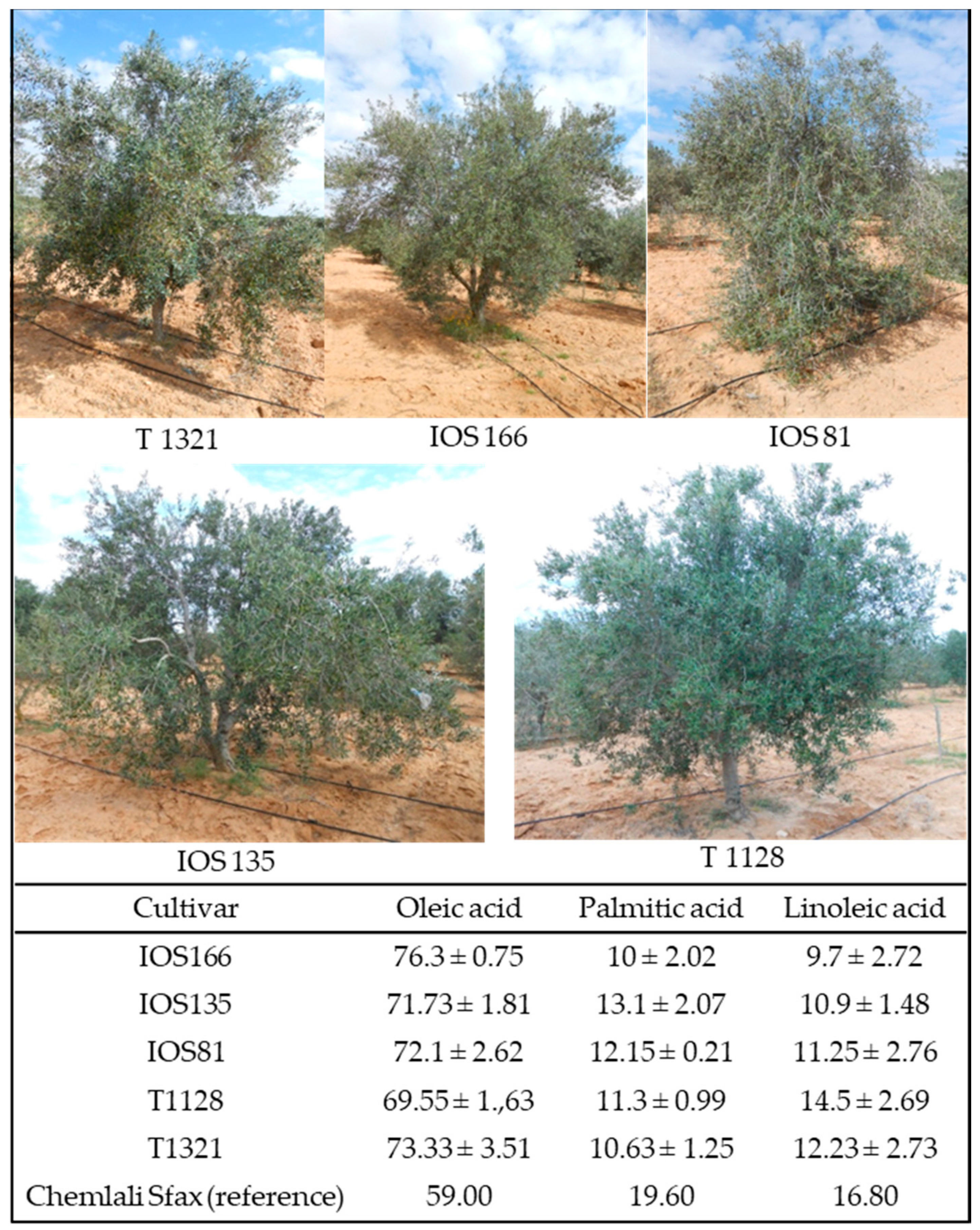
| Type of Characterization | Reference | |
|---|---|---|
| Morphologic/Agronomic | Trigui and Msallem 2002 [50] | |
| Laaribi et al., 2017 [51] | ||
| Khabou et al., 2006 [52] | ||
| Hannachi et al., 2010 [65] | ||
| Mezghani et al., 2019 [66] | ||
| Ben Amar et al., 2015 [67] | ||
| Biochemical | Rjiba et al., 2009 [40] | |
| Ben Abdallah et al., 2018 [46] | ||
| Rejeb et al., 2019 [47] | ||
| Grati-Kamoun et al., 2001 [53] | ||
| Zarrouk et al., 2009 [54] | ||
| Guellaoui, et al., 2021 [68] | ||
| Hannachi et al., 2013 [69] | ||
| Ben Amar 2021 [70] | ||
| Dabbou et al., 2010 [71] | ||
| Omri et al., 2020 [72] | ||
| Chtourou et al., 2021 [73] | ||
| Molecular | RAPD | Laaribi et al., 2017 [51] |
| AFLP | Grati-Kamoun et al., 2006 [57] | |
| Saddoud Debbabi et al., 2021 [49] | ||
| Laaribi et al., 2017 [51] | ||
| Ben Ali et al., 2011 [58] | ||
| Rekik et al., 2008 [59] | ||
| ISSR/SSR | Fendri et al., 2010 [60] | |
| Ben Mohamed et al., 2017 [61] | ||
| Abdelhamid et al., 2017 [62] | ||
| Hannachi, et al., 2010 [65] | ||
| Dridi, et al., 2018 [74] | ||
| SNP | Ben Ayed et al., 2014 [63] Ben Ayed et al., 2019 [64] | |
Publisher’s Note: MDPI stays neutral with regard to jurisdictional claims in published maps and institutional affiliations. |
© 2022 by the authors. Licensee MDPI, Basel, Switzerland. This article is an open access article distributed under the terms and conditions of the Creative Commons Attribution (CC BY) license (https://creativecommons.org/licenses/by/4.0/).
Share and Cite
Debbabi, O.S.; Amar, F.B.; Rahmani, S.M.; Taranto, F.; Montemurro, C.; Miazzi, M.M. The Status of Genetic Resources and Olive Breeding in Tunisia. Plants 2022, 11, 1759. https://doi.org/10.3390/plants11131759
Debbabi OS, Amar FB, Rahmani SM, Taranto F, Montemurro C, Miazzi MM. The Status of Genetic Resources and Olive Breeding in Tunisia. Plants. 2022; 11(13):1759. https://doi.org/10.3390/plants11131759
Chicago/Turabian StyleDebbabi, Olfa Saddoud, Fathi Ben Amar, Sameh Mnasri Rahmani, Francesca Taranto, Cinzia Montemurro, and Monica Marilena Miazzi. 2022. "The Status of Genetic Resources and Olive Breeding in Tunisia" Plants 11, no. 13: 1759. https://doi.org/10.3390/plants11131759
APA StyleDebbabi, O. S., Amar, F. B., Rahmani, S. M., Taranto, F., Montemurro, C., & Miazzi, M. M. (2022). The Status of Genetic Resources and Olive Breeding in Tunisia. Plants, 11(13), 1759. https://doi.org/10.3390/plants11131759










